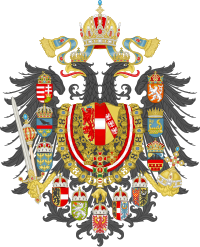
This is a list of heads of government under Austrian Emperors .

This is a list of heads of government under Austrian Emperors .
From 1664/69 the Privy Conference (Geheime Konferenz), a committee of the Imperial Privy Council ( Geheimer Rat ), provided advice to Emperor Leopold I whereby the Austrian Court Chancellor, responsible for the Habsburg 'Hereditary Lands', served as rapporteur and thereby gained increasing influence. The Habsburg diplomatic service was re-organised, when Emperor Charles VI by resolution of 1720 declared Court Chancellor Philipp Ludwig Wenzel von Sinzendorf responsible for foreign policy issues. Upon Sinzendorf's death in February 1742, Archduchess Maria Theresa finally separated the central Habsburg State Chancellery responsible of Foreign Affairs from the domestic Austrian Court Chancellery.
| Portrait | Name | Began | Ended |
|---|---|---|---|
 | Philipp Ludwig Wenzel Graf von Sinzendorf (1671 – 1742) | 1715 | 8 February 1742 |
 | Anton Corfiz Graf von Uhlfeld (1699 – 1769) | 14 February 1742 | 13 May 1753 |
 | Wenzel Anton Graf (from 1764, Fürst) von Kaunitz-Rietberg (1711 – 1794) | 13 May 1753 | 19 August 1792 |
 | Johann Philipp Graf von Cobenzl (1741 – 1810) | 19 August 1792 | 27 March 1793 |
 | Johann Amadeus Francis de Paula von Thugut (1736 – 1818) | 27 March 1793 | 28 September 1800 |
 | Ferdinand von Trauttmansdorff (1749 – 1827) | 28 September 1800 | 11 August 1804 |
| Portrait | Name (Birth–Death) | Post | Term of office | Political party | |
|---|---|---|---|---|---|
 | Ludwig von Cobenzl (1753–1809) | State Chancellors of the Habsburg Monarchy | 11 August 1804 | 25 December 1805 | Nonpartisan |
 | Johann Philipp Stadion, Count von Warthausen (1763–1824) | State Chancellors of the Habsburg Monarchy | 25 December 1805 | 4 October 1809 | Nonpartisan |
 | Klemens von Metternich (1773–1859) | State Chancellor of the Austrian Empire | 8 October 1809 | 25 May 1821 | Nonpartisan |
| 25 May 1821 | 13 March 1848 | ||||
| Portrait | Name (Birth–Death) | Post | Term of office | Political party | |
|---|---|---|---|---|---|
 | Prince Klemens von Metternich (1773–1859) | State Chancellor of the Austrian Empire | 8 October 1809 | 25 May 1821 | Nonpartisan |
| 25 May 1821 | 13 March 1848 | ||||
 | Count Franz Anton von Kolowrat-Liebsteinsky (1778–1861) | Minister-President of the Austrian Empire | 20 March 1848 | 19 April 1848 | Nonpartisan |
 | Charles-Louis, Count of Ficquelmont (1777–1857) | Minister-President of the Austrian Empire | 19 April 1848 | 4 May 1848 | Nonpartisan |
 | Baron Franz von Pillersdorf (1786–1862) | Minister-President of the Austrian Empire | 4 May 1848 | 8 July 1848 | Nonpartisan |
 | Baron Anton von Doblhoff-Dier (1800–1872) | Minister-President of the Austrian Empire | 8 July 1848 | 18 July 1848 | Nonpartisan |
 | Baron Johann von Wessenberg-Ampringen (1773–1858) | Minister-President of the Austrian Empire | 18 July 1848 | 21 November 1848 | Nonpartisan |
 | Prince Felix of Schwarzenberg (1800–1852) | Minister-President of the Austrian Empire | 21 November 1848 | 5 April 1852 | Nonpartisan |
This is a list of heads of government under Emperor Franz Joseph I of Austria . Franz Joseph was born on 18 August 1830 and died on 21 November 1916, his imperial reign lasted from 2 December 1848 to 21 November 1916. His predecessor was Ferdinand I & V and his successor was Charles I & IV.
Franz Joseph ruled over the Austrian Empire which had a Minister-President and later a Chairman of the Ministers' Conference as head of government. After the Austro-Hungarian Compromise of 1867 the joint monarchy of Austria-Hungary had their own heads of government; the Minister-President of Cisleithania for Cisleithania (the Austrian part of the empire) and the Prime Minister of the Kingdom of Hungary for Transleithania (the Hungarian part of the empire).
1 Minister-President of the Austrian Empire, 6 Chairman of the Ministers' Conference of the Austrian Empire, 22 Ministers-President of Cisleithania and 14 Prime Ministers of the Kingdom of Hungary have served under the reign of Emperor Franz Joseph I.
This is a list of heads of government under Emperor Charles I of Austria . Charles was born on 17 August 1887 and died on 1 April 1922, his imperial reign lasted from 21 November 1916 to 11 November 1918. His predecessor was Franz Joseph I. Since the Austro-Hungarian Empire dissolved and the monarchy abolished on 11 November 1918 Charles was the last Austrian Emperor and thus not succeeded.
5 Ministers-President of Cisleithania and 5 Prime Ministers of the Kingdom of Hungary have served under the reign of Emperor Charles I.
| Portrait | Name (Birth–Death) | Post | Term of office | Political party | |
|---|---|---|---|---|---|
 | Count Stephan Burián von Rajecz (1851–1922) | Chairman of the Ministers' Council for Common Affairs | 13 January 1915 | 22 December 1916 | Nonpartisan |
 | Count Ottokar Czernin von und zu Chudenitz (1872–1932) | Chairman of the Ministers' Council for Common Affairs | 22 December 1916 | 16 April 1918 | Nonpartisan |
 | Count Stephan Burián von Rajecz (1851–1922) | Chairman of the Ministers' Council for Common Affairs | 16 April 1918 | 24 October 1918 | Nonpartisan |
 | Count Gyula Andrássy de Csíkszentkirály et Krasznahorka (the Younger) (1860–1929) | Chairman of the Ministers' Council for Common Affairs | 24 October 1918 | 2 November 1918 | Nonpartisan |
| Portrait | Name (Birth–Death) | Post | Term of office | Political party | |
|---|---|---|---|---|---|
 | Ernest von Koerber (1850–1919) | Minister-President of Cisleithania | 21 October 1916 | 20 December 1916 | (Old) Constitutional Party (German National Association) |
 | Heinrich Clam-Martinic (1863–1932) | Minister-President of Cisleithania | 20 December 1916 | 23 June 1917 | Nonpartisan (German National Association) |
 | Ernst Seidler von Feuchtenegg (1862–1931) | Minister-President of Cisleithania | 23 June 1917 | 27 July 1918 | Nonpartisan |
 | Baron Max Hussarek von Heinlein (1865–1935) | Minister-President of Cisleithania | 27 July 1918 | 27 October 1918 | Christian Social Party |
 | Heinrich Lammasch (1853–1920) | Minister-President of Cisleithania | 27 October 1918 | 11 November 1918 | Christian Social Party |
| Picture | Name (Birth–Death) | Post | Term of Office | Political party | |
|---|---|---|---|---|---|
 | István Tisza (1861–1918) 2nd term | Prime Minister of the Kingdom of Hungary | 10 June 1913 | 15 June 1917 | National Party of Work |
 | Móric Esterházy (1881–1960) | Prime Minister of the Kingdom of Hungary | 15 June 1917 | 20 August 1917 | Independent |
 | Sándor Wekerle (1848–1921) 3rd term | Prime Minister of the Kingdom of Hungary | 20 August 1917 | 30 October 1918 | National Constitution Party → '48 Constitution Party |
 | János Hadik (1863–1933) | Prime Minister of the Kingdom of Hungary | 30 October 1918 | 31 October 1918 | National Constitution Party |
 | Mihály Károlyi (1875–1955) | Prime Minister of the Kingdom of Hungary | 31 October 1918 | 16 November 1918 | F48P–Károlyi |

Franz Joseph I or Francis Joseph I was Emperor of Austria, King of Hungary, and the other states of the Austro-Hungarian Empire from 2 December 1848 until his death. From 1 May 1850 to 24 August 1866 he was also President of the German Confederation. He was the longest-reigning ruler of the Austro-Hungarian Empire, as well as the longest-reigning emperor and seventh-longest-reigning monarch of any country in history.

The Federal Chancellor of the Republic of Austria is the head of government of the Republic of Austria. The position corresponds to that of Prime Minister in several other parliamentary democracies.

The Emperor of Austria was the ruler of the Austrian Empire and later the Austro-Hungarian Empire. A hereditary imperial title and office proclaimed in 1804 by Holy Roman Emperor Francis II, a member of the House of Habsburg-Lorraine, and continually held by him and his heirs until Charles I relinquished power in 1918.

The House of Lorraine originated as a cadet branch of the House of Metz. It inherited the Duchy of Lorraine in 1473 after the death without a male heir of Nicholas I, Duke of Lorraine. By the marriage of Francis of Lorraine to Maria Theresa of Austria in 1736, and with the success in the ensuing War of the Austrian Succession (1740–1748), the House of Lorraine was joined to the House of Habsburg and became known as the House of Habsburg‑Lorraine. Francis, his sons Joseph II and Leopold II, and his grandson Francis II were the last four Holy Roman emperors from 1745 until the dissolution of the empire in 1806. The House of Habsburg-Lorraine inherited the Habsburg Empire, ruling the Austrian Empire and then Austria-Hungary until the dissolution of the monarchy in 1918.

The Imperial Council was the legislature of the Austrian Empire from 1861, and from 1867 the legislature of Cisleithania within Austria-Hungary. It was a bicameral body: the upper house was the House of Lords, and the lower house was the House of Deputies. To become law, bills had to be passed by both houses, signed by the government minister responsible, and then granted royal assent by the Emperor. After having been passed, laws were published in the Reichsgesetzblatt. In addition to the Imperial Council, the fifteen individual crown lands of Cisleithania had their own diets.

The phrase Imperial and Royal, typically abbreviated as k. u. k., k. und k., k. & k. in German, cs. és k. in Hungarian, c. a k. in Czech, C. i K. in Polish, c. in k. in Slovenian, c. i kr. in Croatian, ц. и кр. in Serbian, and I.R. in Italian, refers to the court/government of the Habsburgs in a broader historical perspective. Some modern authors restrict its use to the Dual Monarchy of Austria-Hungary from 1867 to 1918.
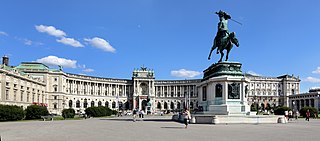
The Hofburg is the former principal imperial palace of the Habsburg dynasty. Located in the centre of Vienna, it was built in the 13th century and expanded several times afterwards. It also served as the imperial winter residence, as Schönbrunn Palace was the summer residence. Since 1946 it is the official residence and workplace of the president of Austria.
The House of Auersperg is an Austrian princely family, which held estates in Austria and Tengen. The princely family of Auersperg was a junior branch of the house of Counts of Auersperg from Carniola, one of the hereditary Habsburg duchies in what is now Slovenia. It rose to princely status in 1653 and after acquiring Tengen, they became immediate Princes of the Holy Roman Empire. The princes of Auersperg also held at various times the duchies of Münsterberg and Gottschee. Their territories were mediatised by Austria and Baden in 1806. The family is counted as high nobility.
Felix Ludwig Johann Friedrich, Prince of Schwarzenberg was a Bohemian nobleman and an Austrian statesman who restored the Austrian Empire as a European great power following the Revolutions of 1848. He served as Minister-President of the Austrian Empire and Foreign Minister of the Austrian Empire from 1848 to 1852.

Heinrich Lammasch was an Austrian jurist. He was a professor of criminal and international law, a member of the Hague Arbitration Tribunal, and served as the last Minister-President of Austria for a few weeks in October and November 1918. He was the first and only non-noble to serve as Minister-President in the Austrian half of the Habsburg Monarchy.

Ernest Karl Franz Joseph Thomas Friedrich von Koerber was an Austrian liberal statesman who served as prime minister of the Austrian portion of Austria-Hungary from 1900 to 1904 and again in 1916.

The Hofkriegsrat established in 1556 was the central military administrative authority of the Habsburg monarchy until 1848 and the predecessor of the Austro-Hungarian Ministry of War. The agency was directly subordinated to the Habsburg emperors with its seat in Vienna.

The House of Habsburg-Lorraine originated from the marriage in 1736 of Francis III, Duke of Lorraine and Bar, and Maria Theresa of Austria, later successively Queen of Bohemia, Queen of Hungary and Archduchess of Austria. Its members are the legitimate surviving line of the House of Habsburg and the House of Lorraine, inheriting their patrimonial possessions and vocation to the Empire from the female descendants of the House of Habsburg and the male line of the House of Lorraine.
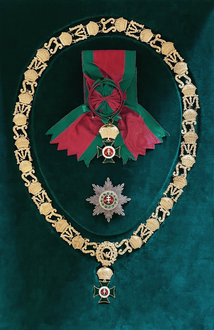
The Order of Saint Stephen was an order of chivalry founded in 1764 by Maria Theresa. In 1938, Miklós Horthy took the rights and activities of Grand Master as Regent of Hungary. The name of the Order changed to the Royal Hungarian Order of Saint Stephen. The Order was terminated at the time of the proclamation of the Second Hungarian Republic in 1946. It was recreated in 2011 as the Hungarian Order of Saint Stephen, and to this day remains the highest order in Hungary.
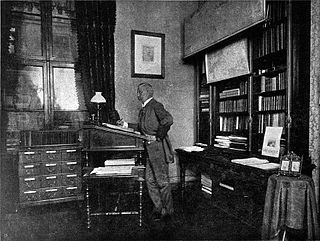
Heinrich Ritter von Wittek was an Austrian politician of the Christian Social Party (CS). He served as head of the k.k. Railway Ministry and as Minister-President of Cisleithania for four weeks in 1899/1900.

The Imperial and Royal Minister of War, until 1911: Reich Minister of War (Reichskriegsminister), was the head of one of the three common ministries shared by the two states which made up the dual monarchy of Austria-Hungary from its creation in the Compromise of 1867 until its dissolution in 1918.

The Imperial and Royal Foreign Ministry was the ministry responsible for the foreign relations of the Austro-Hungarian Empire from the formation of the Dual Monarchy in 1867 until it was dissolved in 1918.

Philipp Ludwig Wenzel von Sinzendorf was an Austrian diplomat and statesman who for nearly four decades served as Court Chancellor responsible of foreign affairs of the Habsburg monarchy.
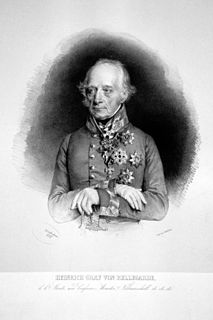
General of the Cavalry was a rank in the Imperial Army of the Holy Roman Empire, Imperial Army of the Austrian Empire and the Army of Austria-Hungary.